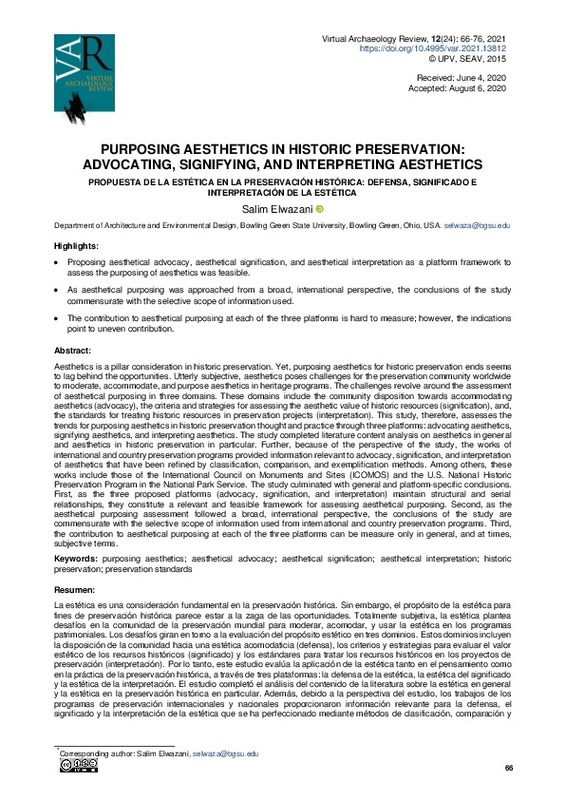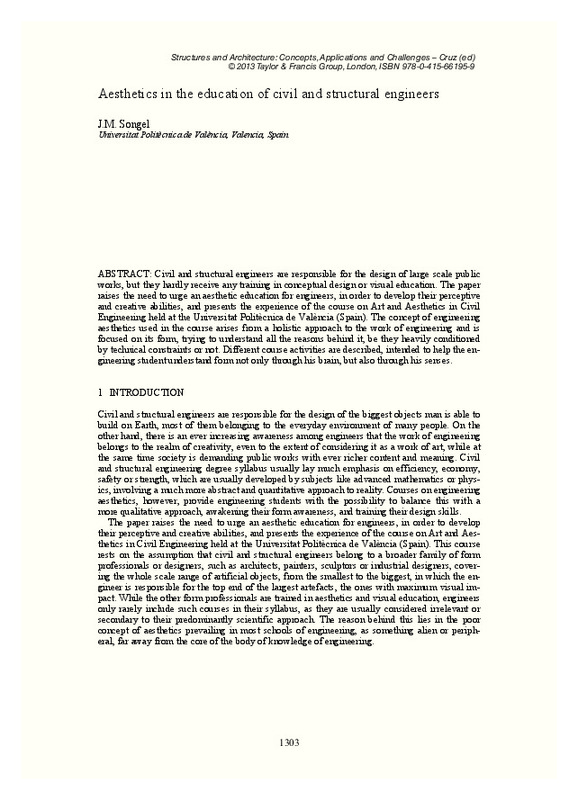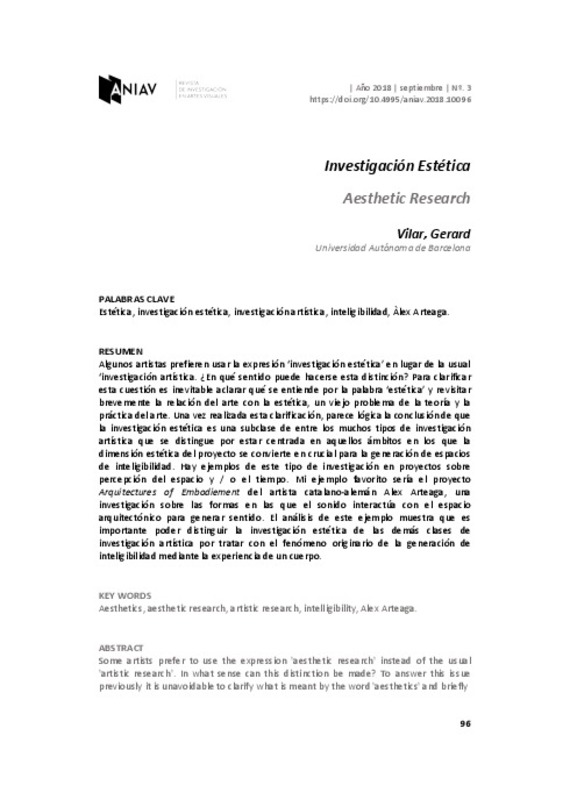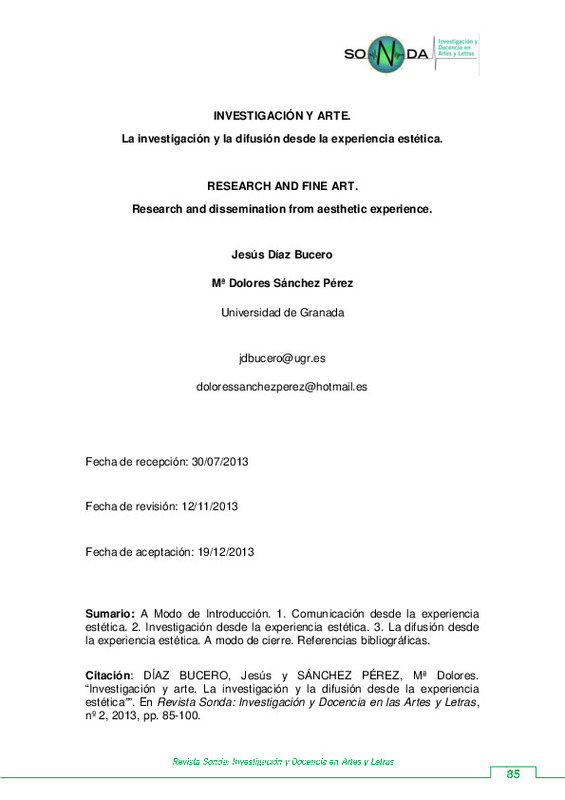JavaScript is disabled for your browser. Some features of this site may not work without it.
Buscar en RiuNet
Listar
Mi cuenta
Estadísticas
Ayuda RiuNet
Admin. UPV
Purposing aesthetics in historic preservation: advocating, signifying, and interpreting aesthetics
Mostrar el registro sencillo del ítem
Ficheros en el ítem
| dc.contributor.author | Elwazani, Salim
|
es_ES |
| dc.date.accessioned | 2021-02-16T11:55:03Z | |
| dc.date.available | 2021-02-16T11:55:03Z | |
| dc.date.issued | 2021-01-19 | |
| dc.identifier.uri | http://hdl.handle.net/10251/161437 | |
| dc.description.abstract | [EN] Aesthetics is a pillar consideration in historic preservation. Yet, purposing aesthetics for historic preservation ends seems to lag behind the opportunities. Utterly subjective, aesthetics poses challenges for the preservation community worldwide to moderate, accommodate, and purpose aesthetics in heritage programs. The challenges revolve around the assessment of aesthetical purposing in three domains. These domains include the community disposition towards accommodating aesthetics (advocacy), the criteria and strategies for assessing the aesthetic value of historic resources (signification), and, the standards for treating historic resources in preservation projects (interpretation). This study, therefore, assesses the trends for purposing aesthetics in historic preservation thought and practice through three platforms: advocating aesthetics, signifying aesthetics, and interpreting aesthetics. The study completed literature content analysis on aesthetics in general and aesthetics in historic preservation in particular. Further, because of the perspective of the study, the works of international and country preservation programs provided information relevant to advocacy, signification, and interpretation of aesthetics that have been refined by classification, comparison, and exemplification methods. Among others, these works include those of the International Council on Monuments and Sites (ICOMOS) and the U.S. National Historic Preservation Program in the National Park Service. The study culminated with general and platform-specific conclusions. First, as the three proposed platforms (advocacy, signification, and interpretation) maintain structural and serial relationships, they constitute a relevant and feasible framework for assessing aesthetical purposing. Second, as the aesthetical purposing assessment followed a broad, international perspective, the conclusions of the study are commensurate with the selective scope of information used from international and country preservation programs. Third, the contribution to aesthetical purposing at each of the three platforms can be measure only in general, and at times, subjective terms.Highlights:Proposing aesthetical advocacy, aesthetical signification, and aesthetical interpretation as a platform framework to assess the purposing of aesthetics was feasible.As aesthetical purposing was approached from a broad, international perspective, the conclusions of the study commensurate with the selective scope of information used.The contribution to aesthetical purposing at each of the three platforms is hard to measure; however, the indications point to uneven contribution. | es_ES |
| dc.description.abstract | [ES] La estética es una consideración fundamental en la preservación histórica. Sin embargo, el propósito de la estética para fines de preservación histórica parece estar a la zaga de las oportunidades. Totalmente subjetiva, la estética plantea desafíos en la comunidad de la preservación mundial para moderar, acomodar, y usar la estética en los programas patrimoniales. Los desafíos giran en torno a la evaluación del propósito estético en tres dominios. Estos dominios incluyen la disposición de la comunidad hacia una estética acomodaticia (defensa), los criterios y estrategias para evaluar el valor estético de los recursos históricos (significación) y los estándares para tratar los recursos históricos en los proyectos de preservación (interpretación). Por lo tanto, este estudio evalúa las tendencias de la estética en el pensamiento y la práctica de la preservación histórica a través de tres plataformas: la defensa de la estética, la estética del significado y la estética de la interpretación. El estudio completó el análisis del contenido de la literatura sobre la estética en general y la estética en la preservación histórica en particular. Además, debido a la perspectiva del estudio, los trabajos de los programas de preservación internacionales y nacionales proporcionaron información relevante para la defensa, la significación y la interpretación de la estética que se ha perfeccionado mediante métodos de clasificación, comparación y ejemplificación. Entre otros, estos trabajos incluyen los del Consejo Internacional de Monumentos y Sitios (ICOMOS) y el Programa de Preservación Histórica Nacional de los Estados Unidos del Servicio de Parques Nacionales. El estudio culminó con conclusiones generales y específicas de cada plataforma. En primer lugar, cómo las tres plataformas propuestas (defensa, significación e interpretación) mantienen relaciones estructurales y en serie, constituyen un marco relevante y factible para evaluar el propósito estético. En segundo lugar, cómo la evaluación de la finalidad estética sigue una perspectiva internacional amplia, de modo que las conclusiones del estudio son acordes al alcance selectivo de la información utilizada en los programas de preservación internacionales y de cada país. En tercer lugar, cómo la contribución a la finalidad estética en cada una de los tres dominios puede medirse solo en términos generales y, en ocasiones, subjetivos. | es_ES |
| dc.language | Inglés | es_ES |
| dc.publisher | Universitat Politècnica de València | es_ES |
| dc.relation.ispartof | Virtual Archaeology Review | es_ES |
| dc.rights | Reconocimiento - No comercial - Sin obra derivada (by-nc-nd) | es_ES |
| dc.subject | Purposing aesthetics | es_ES |
| dc.subject | Aesthetical advocacy | es_ES |
| dc.subject | Aesthetical signification | es_ES |
| dc.subject | Aesthetical interpretation | es_ES |
| dc.subject | Historic preservation | es_ES |
| dc.subject | Preservation standards | es_ES |
| dc.subject | Estética intencional | es_ES |
| dc.subject | Defensa de la estética | es_ES |
| dc.subject | Significado estético | es_ES |
| dc.subject | Interpretación estética | es_ES |
| dc.subject | Conservación histórica | es_ES |
| dc.subject | Estándares de conservación o preservación | es_ES |
| dc.title | Purposing aesthetics in historic preservation: advocating, signifying, and interpreting aesthetics | es_ES |
| dc.title.alternative | Propuesta de la estética en la preservación histórica: defensa, significado e interpretación de la estética | es_ES |
| dc.type | Artículo | es_ES |
| dc.identifier.doi | 10.4995/var.2021.13812 | |
| dc.rights.accessRights | Abierto | es_ES |
| dc.description.bibliographicCitation | Elwazani, S. (2021). Purposing aesthetics in historic preservation: advocating, signifying, and interpreting aesthetics. Virtual Archaeology Review. 12(24):66-76. https://doi.org/10.4995/var.2021.13812 | es_ES |
| dc.description.accrualMethod | OJS | es_ES |
| dc.relation.publisherversion | https://doi.org/10.4995/var.2021.13812 | es_ES |
| dc.description.upvformatpinicio | 66 | es_ES |
| dc.description.upvformatpfin | 76 | es_ES |
| dc.type.version | info:eu-repo/semantics/publishedVersion | es_ES |
| dc.description.volume | 12 | es_ES |
| dc.description.issue | 24 | es_ES |
| dc.identifier.eissn | 1989-9947 | |
| dc.relation.pasarela | OJS\13812 | es_ES |
| dc.description.references | Australia ICOMOS. (2013). The Burra Charter: The Australia ICOMOS Charter for Places of Cultural Significance. Retrieved May 30, 2020, from https://australia.icomos.org/publications/burra-charter-practice-notes/#bc | es_ES |
| dc.description.references | Barenboim, D. (2017). Reclaiming Tangible Heritage: Cultural Aesthetics, Materiality, and Ethnic Belonging in the Maya Diaspora. The Journal of Latin American and Caribbean 23(1): 113-130. https://doi.org/10.1111/jlca.12284 | es_ES |
| dc.description.references | Brady, E. (2006). Aesthetics in Practice: Valuing the Natural World." Environmental Values 15(3), 277-291. https://doi.org/10.3197/096327106778226202 | es_ES |
| dc.description.references | Crippen, M. (2019). Aesthetics and action: situations, emotional perception and the Kuleshov effect. Synthese. https://doi.org/10.1007/s11229-019-02110-2 | es_ES |
| dc.description.references | Ebdrup, T. R. (2017). The aesthetics steps: differentiated approaches to spatial aesthetics. Artifact: Journal of Design Practice, 3(3), 6.1-6.12(1). https://doi.org/10.14434/artifact.v3i3.3119 | es_ES |
| dc.description.references | Falasca-Zamponi, S. (1997). Fascist Spectacle: The Aesthetics of Power in Mussolini's Italy. University of California Press. https://doi.org/10.1525/9780520926158 | es_ES |
| dc.description.references | Halperin, C. T., & Garrido, J. L. (2019). Architectural Aesthetics, Orientations, and Reuse at the Terminal Classic Maya Site of Ucanal, Petén, Guatemala. Journal of Field Archaeology 45(1), 46-66. https://doi.org/10.1080/00934690.2019.1676033 | es_ES |
| dc.description.references | ICOMOS New Zealand. (2010). Charter for the Conservation of Places of Cultural Heritage Value. Retrieved May 30, 2020, from https://www.icomos.org/images/DOCUMENTS/Charters/ICOMOS_NZ_Charter_2010_FINAL_11_Oct_2010.pdf | es_ES |
| dc.description.references | ICOMOS. (1931). The Athens Charter for the Restoration of Historic Monuments. Retrieved May 30, 2020, from https://www.icomos.org/en/resources/charters-and-texts/179-articles-en-francais/ressources/charters-and-standards/167-the-athens-charter-for-the-restoration-of-historic-monuments | es_ES |
| dc.description.references | ICOMOS. (1964). International Charter for the Conservation and Restoration of Monuments and Sites, the Venice Charter. Retrieved May 30, 2020, from http://www.icomos.org/charters/venice_e.pdf | es_ES |
| dc.description.references | ICOMOS. (1987). Charter for the Conservation of Historic Towns and Urban Areas: The Washington Charter. Retrieved May 30, 2020, from https://www.icomos.org/images/DOCUMENTS/Charters/towns_e.pdf | es_ES |
| dc.description.references | ICOMOS. (1993). Appleton Charter for the Protection and Enhancement of the Built Environment. Retrieved May 29, 2020, from https://www.icomos.org/en/resources/charters-and-texts | es_ES |
| dc.description.references | ICOMOS. (1996). The Declaration of San Antonio. Retrieved May 30, 2020, from https://www.icomos.org/en/resources/charters-and-texts/179-articles-en-francais/ressources/charters-and-standards/188-the-declaration-of-san-antonio | es_ES |
| dc.description.references | ICOMOS. (1999). Charter on the Built Vernacular Heritage. Retrieved May 30, 2020, from https://www.icomos.org/images/DOCUMENTS/Charters/vernacular_e.pdf | es_ES |
| dc.description.references | ICOMOS. (1999). International Cultural Tourism Charter. Retrieved May 30, 2020, from https://www.icomos.org/images/DOCUMENTS/Charters/INTERNATIONAL_CULTURAL_TOURISM_CHARTER.pdf | es_ES |
| dc.description.references | ICOMOS. (1999). Principles for the Preservation of Historic Timber Structures. Retrieved May 31, 2020, from https://www.icomos.org/images/DOCUMENTS/Charters/wood_e.pdf | es_ES |
| dc.description.references | ICOMOS. (2003). Principles for the Preservation and Conservation-Restoration of Wall Paintings. Retrieved May 30, 2020, from https://www.icomos.org/images/DOCUMENTS/Charters/wallpaintings_e.pdf | es_ES |
| dc.description.references | ICOMOS. (2005). Xi'an Declaration on the Conservation of the Setting of Heritage Structures, Sites and Areas. Retrieved May 31, 2020, from 2005. https://www.icomos.org/images/DOCUMENTS/Charters/xian-declaration.pdf | es_ES |
| dc.description.references | ICOMOS. (2008). Charter on the Interpretation and Presentation of Cultural Heritage Sites. Retrieved May 30, 2020, from https://www.icomos.org/images/DOCUMENTS/Charters/interpretation_e.pdf | es_ES |
| dc.description.references | ICOMOS. (2008). Québec Declaration on the Preservation of the Spirit of Place. Retrieved May 31, 2020, from https://www.icomos.org/images/DOCUMENTS/Charters/GA16_Quebec_Declaration_Final_EN.pdf | es_ES |
| dc.description.references | ICOMOS. (2011). The Paris Declaration on Heritage as a Driver of Development. Retrieved May 31, 2020, from https://www.icomos.org/images/DOCUMENTS/Charters/GA2011_Declaration_de_Paris_EN_20120109.pdf | es_ES |
| dc.description.references | ICOMOS. (2011). The Valletta Principles for the Safeguarding and Management of Historic Cities, Towns and Urban Areas. Retrieved May 31, 2020, from https://www.icomos.org/Paris2011/GA2011_CIVVIH_text_EN_FR_final_20120110.pdf | es_ES |
| dc.description.references | Lamarque, P. (2016). Reflections on the Ethics and Aesthetics of Restoration and Conservation, the British Journal of Aesthetics, 56(3), 281-299. https://doi.org/10.1093/aesthj/ayw041 | es_ES |
| dc.description.references | Munro, T., & Scruton R. (n.d.). Aesthetics. In Encyclopedia Britannica. Retrieved May 31, 2020, from https://www.britannica.com/topic/aesthetics | es_ES |
| dc.description.references | NPS TPS (n.d.). Preservation as a Treatment. Retrieved May 31, 2020, from https://www.nps.gov/tps/standards/four-treatments/treatment-preservation.htm | es_ES |
| dc.description.references | NPS TPS (n.d.). Rehabilitation as a Treatment. Retrieved May 31, 2020, from https://www.nps.gov/tps/standards/four-treatments/treatment-rehabilitation.htm | es_ES |
| dc.description.references | NPS TPS (n.d.). Walkthrough Historic Buildings: Identifying the Visual Character of Historic Buildings. Retrieved May 31, 2020, from https://www.nps.gov/tps/education/walkthrough/index.htm | es_ES |
| dc.description.references | NPS NRHP (1980). Akron Rural Cemetery Buildings. Retrieved September 28, 2020, from https://catalog.archives.gov/id/71991545 | es_ES |
| dc.description.references | NPS NRHP (1995) Bulletin 15, How to Apply the National Register Criteria for Evaluation. Retrieved May 31, 2020, from https://www.nps.gov/subjects/nationalregister/publications.htm | es_ES |
| dc.description.references | NPS NRHP (2005). New York MPS Elmwood Park. Retrieved September 28, 2020, from https://catalog.archives.gov/id/75314079 | es_ES |
| dc.description.references | NPS TPS (2017). Guidelines for the Treatment of Historic Properties. Retrieved May 31, 2020, from https://www.nps.gov/tps/standards/four-treatments.htm | es_ES |
| dc.description.references | Page, M. (2017). Beyond Pretty Buildings. Chronicle of Higher Education. 63(19). | es_ES |
| dc.description.references | Plato, L., & Meskin, A. (2014). Aesthetic Value. In AC Michalos. (ed.), Encyclopedia of Quality of Life and Well-Being Research. 76-78. Springer. https://aaron-meskin.org/publications/ https://doi.org/10.1007/978-94-007-0753-5_3349 | es_ES |
| dc.description.references | Saito, Y. (2019). Aesthetics of the Everyday. In Zalta, E. N. (ed.), The Stanford Encyclopedia of Philosophy. https://plato.stanford.edu/archives/win2019/entries/aesthetics-of-everyday | es_ES |
| dc.description.references | Stanford University. (2019). Environmental Aesthetics. In The Stanford Encyclopedia of Philosophy. Retrieved May 30, 2020, from https://plato.stanford.edu/archives/sum2019/entries/environmental-aesthetics | es_ES |
| dc.description.references | Tenen, L. (2019). Aesthetic and Historical Values - Their Difference and Why It Matters. Environmental Values. White Horse Press. https://doi.org/10.3197/096327119X15747870303863 | es_ES |
| dc.description.references | Van Camp, J. (1980). Aesthetics and the Law of Historic Preservation. Proceedings of the Annual Meeting of the American Society for Aesthetics, Milwaukee, October 22-25. Retrieved May 31, 2020, from http://web.csulb.edu/~jvancamp/ASA_1980.pdf | es_ES |
| dc.description.references | Vihanninjoki, V. (2019). Urban Places as Aesthetic Phenomena: Framework for a Place-Based Ontology of Urban Lifeworld. Topoi. https://doi.org/10.1007/s11245-018-9601-1 | es_ES |











